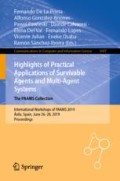Abstract
Flood routing models are mathematical methods used to predict the changes over the time in variables such as the magnitude, speed and shape of a flood wave when water moves in a river, a stream or a reservoir. These techniques are widely used in water engineering for flood prediction and many other applications such as dam design, geographic and urban planning, disaster prevention, and so on. Flood routing models typically depend on some parameters that must be estimated from data. Several techniques have been described in the literature for this task. Among them, those based on swarm intelligence are getting increasing attention from the scientific community during the last few years. In this context, the present contribution applies a powerful swarm intelligence technique called bat algorithm to perform parametric learning of a hydrological model for nonlinear river flood routing. The method is applied to data of a real-world example of a river reach with very good results.
Access this chapter
Tax calculation will be finalised at checkout
Purchases are for personal use only
References
Alihodzic, A., Tuba, M.: Improved bat algorithm applied to multilevel image thresholding. Sci. World J. 2014, 16 (2014). Article ID 176718
Bazargan, J., Norouzi, H.: Investigation the effect of using variable values for the parameters of the linear Muskingum method using the particle swarm algorithm (PSO). Water Resour. Manag. 32(14), 4763–4777 (2018)
Chu, H.J., Chang, L.C.: Applying particle swarm optimization to parameter estimation of the nonlinear Muskingum model. J. Hydrol. Eng. 14(9), 1024–1027 (2009)
Fister, I., Rauter, S., Yang, X.-S., Ljubic, K., Fister Jr., I.: Planning the sports training sessions with the bat algorithm. Neurocomputing 149(Part B), 993–1002 (2015)
Gálvez, A., Fister, I., Fister Jr., I., Osaba, E., Del Ser, J., Iglesias, A.: Automatic fitting of feature points for border detection of skin lesions in medical images with bat algorithm. In: Del Ser, J., Osaba, E., Bilbao, M.N., Sanchez-Medina, J.J., Vecchio, M., Yang, X.-S. (eds.) IDC 2018. SCI, vol. 798, pp. 357–368. Springer, Cham (2018). https://doi.org/10.1007/978-3-319-99626-4_31
Iglesias, A., Gálvez, A., Collantes, M.: Multilayer embedded bat algorithm for B-spline curve reconstruction. Integr. Comput.-Aided Eng. 24(4), 385–399 (2017)
Iglesias, A., Gálvez, A., Collantes, M.: Iterative sequential bat algorithm for free-form rational Bézier surface reconstruction. Int. J. Bio-Inspired Comput. 11(1), 1–15 (2018)
Kashi, S., Minuchehr, A., Poursalehi, N., Zolfaghari, A.: Bat algorithm for the fuel arrangement optimization of reactor core. Ann. Nucl. Energy 64, 144–151 (2014)
Kaveh, A., Zakian, P.: Enhanced bat algorithm for optimal design of skeletal structures. Asian J. Civ. Eng. 15(2), 179–212 (2014)
Kim, J.H., Geem, Z.W., Kim, E.S.: Parameter estimation of the nonlinear Muskingum model using harmony search. J. Am. Water Resour. Assoc. 375, 1131–1138 (2001)
Latif, A., Palensky, P.: Economic dispatch using modified bat algorithm. Algorithms 7(3), 328–338 (2014)
McCarthy G. T.: The unit hydrograph and flood routing. In: Conference North Atlantic Division. US Army Corps of Engineers, New London (1938)
Suárez, P., Iglesias, A.: Bat algorithm for coordinated exploration in swarm robotics. In: Del Ser, J. (ed.) ICHSA 2017. AISC, vol. 514, pp. 134–144. Springer, Singapore (2017). https://doi.org/10.1007/978-981-10-3728-3_14
Suárez, P., Gálvez, A., Iglesias, A.: Autonomous coordinated navigation of virtual swarm bots in dynamic indoor environments by bat algorithm. In: Tan, Y., Takagi, H., Shi, Y., Niu, B. (eds.) ICSI 2017. LNCS, vol. 10386, pp. 176–184. Springer, Cham (2017). https://doi.org/10.1007/978-3-319-61833-3_19
Suárez, P., et al.: Bat algorithm swarm robotics approach for dual non-cooperative search with self-centered mode. In: Yin, H., Camacho, D., Novais, P., Tallón-Ballesteros, A.J. (eds.) IDEAL 2018. LNCS, vol. 11315, pp. 201–209. Springer, Cham (2018). https://doi.org/10.1007/978-3-030-03496-2_23
Suárez, P., Iglesias, A., Gálvez, A.: Make robots be bats: specializing robotic swarms to the bat algorithm. Swarm Evol. Comput. 44, 113–129 (2019)
Vafakhah, M., Dastorani, A., Moghaddam, A.: Optimal parameter estimation for nonlinear Muskingum model based on artificial bee Colony algorithm. EcoPersia 3(1), 847–865 (2015)
Viessman Jr., W., Lewis, G.L.: Introduction to Hydrology. Pearson Education, Upper Saddle River (1974)
Wilson, E.M.: Engineering Hydrology. MacMillan, Hampshire (1974)
Yang, X.-S.: Nature-Inspired Metaheuristic Algorithms, 2nd edn. Luniver Press, Frome (2010)
Yang, X.S.: A new metaheuristic bat-inspired algorithm. In: González, J.R., Pelta, D.A., Cruz, C., Terrazas, G., Krasnogor, N. (eds.) Nature Inspired Cooperative Strategies for Optimization (NICSO 2010). Studies in Computational Intelligence, vol. 284, pp. 65–74. Springer, Berlin (2010). https://doi.org/10.1007/978-3-642-12538-6_6
Yang, X.S.: Bat algorithm for multiobjective optimization. Int. J. Bio-Inspired Comput. 3(5), 267–274 (2011)
Yang, X.S., Gandomi, A.H.: Bat algorithm: a novel approach for global engineering optimization. Eng. Comput. 29(5), 464–483 (2012)
Yang, X.S.: Bat algorithm: literature review and applications. Int. J. Bio-Inspired Comput. 5(3), 141–149 (2013)
Acknowledgments
The authors acknowledge the financial support from the project PDE-GIR of the European Union’s Horizon 2020 research and innovation programme under the Marie Sklodowska-Curie grant agreement No. 778035, the project from the Spanish Ministry of Science, Innovation and Universities (Computer Science National Program) under grant #TIN2017-89275-R of the Agencia Estatal de Investigación and European Funds FEDER (AEI/FEDER, UE), and the project #JU12, of SODERCAN and EU Funds FEDER (SODERCAN/FEDER-UE). The last two authors are also grateful to the Department of Information Science of Toho University for all the facilities given to carry out this work.
Author information
Authors and Affiliations
Corresponding author
Editor information
Editors and Affiliations
Rights and permissions
Copyright information
© 2019 Springer Nature Switzerland AG
About this paper
Cite this paper
Sánchez, R., Suárez, P., Gálvez, A., Iglesias, A. (2019). Swarm Intelligence Approach for Parametric Learning of a Nonlinear River Flood Routing Model. In: De La Prieta, F., et al. Highlights of Practical Applications of Survivable Agents and Multi-Agent Systems. The PAAMS Collection. PAAMS 2019. Communications in Computer and Information Science, vol 1047. Springer, Cham. https://doi.org/10.1007/978-3-030-24299-2_24
Download citation
DOI: https://doi.org/10.1007/978-3-030-24299-2_24
Published:
Publisher Name: Springer, Cham
Print ISBN: 978-3-030-24298-5
Online ISBN: 978-3-030-24299-2
eBook Packages: Computer ScienceComputer Science (R0)

